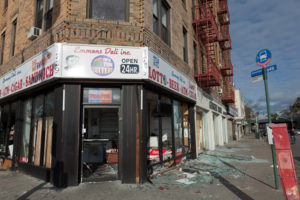

Looters and Disaster Response
A few days after the landfall of Hurricane Katrina in 2005, most of the officers in the New Orleans Police Department were pulled off of rescue operations in an effort to pull the city back from the criminal element, especially looters.
It speaks loudly to the impact crime can have after a disaster. Every officer that was reassigned to handle looters and other lawlessness was an officer that couldn’t be out there looking for the elderly, disabled and injured.
Not All Looters are the Same
You could hold less animosity for the people in a state of panic who stole groceries and other provisions out of survival fears. You might have fewer problems with a family that climbed through a broken window and into the shoe store to put new pairs on each of their children after flooding washed away their belongings.
It’s something completely different when you consider those who loaded up on new furniture, expensive booze, big-screen televisions and other luxuries in the wake of all the chaos.
There were plenty of the latter. Many businesses were cleared out to their walls, and plenty of those goods went well beyond the realm of necessities.
Looters: Catch and Release
Regaining a sense of order was no easy task. Officers had to prioritize who they were hauling in, and in many cases, police were limited to a system of catch and release.
The jail sustained significant damage in the hurricane, leaving the capacity to house offenders at a high premium. It meant law enforcement simply let go many of those causing trouble unless they were involved in violent offenses.
Rampant crime not only affected the crucial work of rescuing those from the floodwaters, but it also stood in the way of those who came in to start repairs on the power grid and other infrastructure.

Looters: Nothing New About Them
Though Hurricane Katrina was a unique situation in so many ways, it isn’t the only example. Reports of looting began to pile up in and near New York City in 2012 after Superstorm Sandy cleared.
Looters aren't solely a modern phenomenon. Looting and crime were rampant following the major hurricane that battered New England in September 1938.
That hurricane came prior to our modern practice of assigning first names to storms, though it came to be known by many as “The Long Island Express” based on its landfall there on Sept. 21, 1938.
New England was blindsided by the storm, which stood among the very worst disasters of the 20th century. The hurricane touched 10 New England states before finally falling apart in southern Quebec, Canada.
The Express left several hundred dead in its wake and caused $4.7 billion in damage by modern monetary figures. Looters then, like the looters in modern times, took full advantage of the disorder.
It’s pertinent to consider the time frame. The hurricane wreaked its havoc amid the Great Depression, and desperation was already at a fevered pitch when the Express rolled through.
Certainly, you couldn’t generalize or pin specific motives on lawbreakers as a whole, whether thinking of long ago or during more recent history. Some looters might have stolen for survival then. Some might have stolen for survival in 2005 and 2012.
Some certainly had profit in mind. Authorities in some locales following the 1938 storm were given “shoot to kill” orders in efforts to restore safety and security among the chaos. Fast-forward 68 years, and police in the wake of Katrina received those same orders.
Looters: History will repeat itself
Some have claimed the modern era is far less civil than past generations. The criminal behavior at play in 1938 and again in the 21st century suggests it isn’t a matter of the era. Those building their natural disaster preparedness plans might note that those who ignore history are doomed to repeat it.

![Best Concealed Carry Guns In 2025 [Field Tested] Wilson Combat EDC X9S 1](https://gundigest.com/wp-content/uploads/Wilson-Combat-EDC-X9S-1-324x160.jpg)


![Best 9mm Carbine: Affordable PCCs [Tested] Ruger Carbine Shooting](https://gundigest.com/wp-content/uploads/Ruger-Carbine-Shooting-100x70.jpg)
![Best AR-15: Top Options Available Today [Field Tested] Harrington and Richardson PSA XM177E2 feature](https://gundigest.com/wp-content/uploads/Harrington-and-Richardson-PSA-XM177E2-feature-100x70.jpg)
